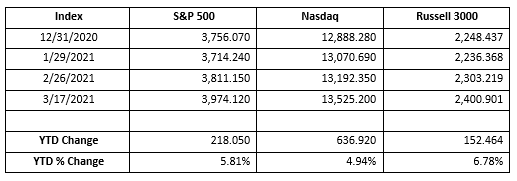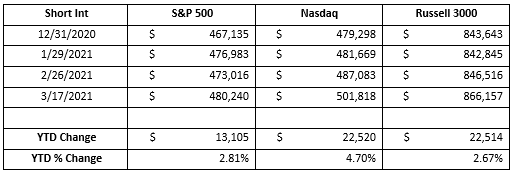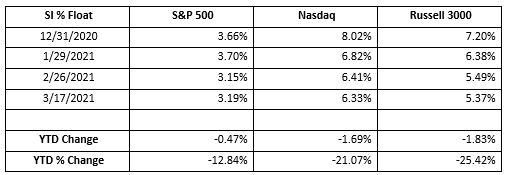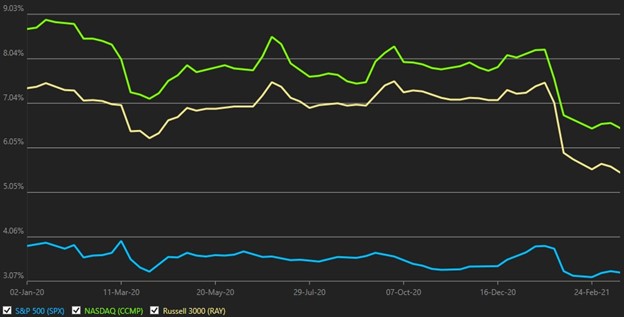There have been several reports stating that short interest has been on the decline in 2021, but that is more a function of using the incorrect metric in measuring short interest rather than the reality of short side holdings. The truth is, while short interest as a % of float has declined the actual dollar value of outstanding short positions has increased.
Due to overall market appreciation and the trend to short over-bought upward trending momentum stocks the average stock price of a shorted stock has increased. This means that short sellers need to short fewer actual shares of a stock in order to achieve the same short dollar exposure. The weighted average price of a shorted stock in the Russell 3000 was $51.29/share on December 31st, 2020 and climbed to $59.44/share as of March 17th, 2021. In less than three months short sellers would need short 16% fewer shares of stock to achieve the same dollar short exposure.
As an example, $100 million of short exposure in GameStop (GME) would have been taken 9.53% of its float shares on December 31st, 2020 (stock price of $19.26) but only 0.87% of its float shares on March 17th, 2021 (stock price $209.81). In this example, short Interest as a % of Float declined by 92% while short interest remained unchanged.
A decline of SI % Float does not necessarily mean that there is less short exposure of a stock in the market, it just means that there are fewer physical shares shorted.
Portfolio risk management, portfolio construction and portfolio profit & loss are all based on the dollar value of a position, not the number of long or short shares. The long\short split of a portfolio is described as $200M long\$100M short and not 50K shares long\25K shares short and I have never heard a trader jump up out of their chair yelling “I just made 10 thousand shares on this trade!” instead they would scream “I just made $100 thousand on this trade!”.
The markets have been up in 2021, so there may be an expectation of some shorts getting squeezed out of their trades.

And while there has been short covering on the short side the overall short exposure in the market has increased in 2021. Shorts have been covering some of their shares in order to keep their total short exposure at acceptable levels as their shorted stocks’ prices increased. The following chart shows the aggregated year-to-date increase in total dollar short interest by index (in $ millions):

2020 -2021 $ Short interest:

Even though short interest as a % of float has decreased:

2020-2021 Short Interest % Float:

The total number of shares shorted on the street has decreased but overall short side exposure has actually slightly increased. Instead of betting seven $10 chips, traders are now betting one $100 chip. Yes, there are fewer chips in the pot, but the value of the pot is larger.
By looking at short interest by sector we can see where short sellers are putting their short exposure. The sectors with the largest short exposure continue to be the Information Technology and Consumer Discretionary sectors, with both having over $200 billion of short interest. But they were two of only four sectors which saw a decrease in short exposure as investors reduced their short risk in Information Technology by -$3.8 billion and by -$6.0 billion in Consumer Discretionary. The stocks with the largest decrease in short interest in these sectors were:


The Financials and Communication Services Sectors had the largest increase of short risk. Short interest in the Financial Sector rose by +$21.7 billion and by +$15.3 billion in the Communication Services Sector. The stocks with the largest increase in short interest in these sectors were:


Overall domestic Short Interest increased by +$42.8 billion and Short Interest as a % of Float decreased by -1.47%. Short Interest and Short Interest as a % of Float by sector are:

Just like on doing all your other daily activities, it is important to use the correct metric when doing market analysis. If you ask your gas station attendant for 120 lbs. of gas instead of 20 gallons you will probably geta expletive filled retort and not a full tank of gas. If you use SI % Float to measure short exposure you might get an answer that is far from the truth. Use SI % Float where it works best, measuring the change in share short selling and share short covering and its effect on price changes, but not as a measure of short exposure in the market.
Looking at short selling trends over time provides insight into overall market sentiment as well as the strength of bearish conviction in individual equities. Our Blacklight SaaS platform and Black APP provides an up to date view of short selling and short covering on an equity, sector, index, or country-wide basis allowing investors\traders to better manage their existing long and short positions.
Research Note written by Ihor Dusaniwsky, Managing Director of Predictive Analytics, S3 Partners, LLC
For deeper insight into short side data and analysis contact me at Ihor.Dusaniwsky@S3Partners.com
Click for 10 Day Complimentary Access to Bloomberg/S3 Black App Pro
The information herein (some of which has been obtained from third party sources without verification) is believed by S3 Partners, LLC (“S3 Partners”) to be reliable and accurate. Neither S3 Partners nor any of its affiliates makes any representation as to the accuracy or completeness of the information herein or accepts liability arising from its use. Prior to making any decisions based on the information herein, you should determine, without reliance upon S3 Partners, the economic risks, and merits, as well as the legal, tax, accounting, and investment consequences, of such decisions.